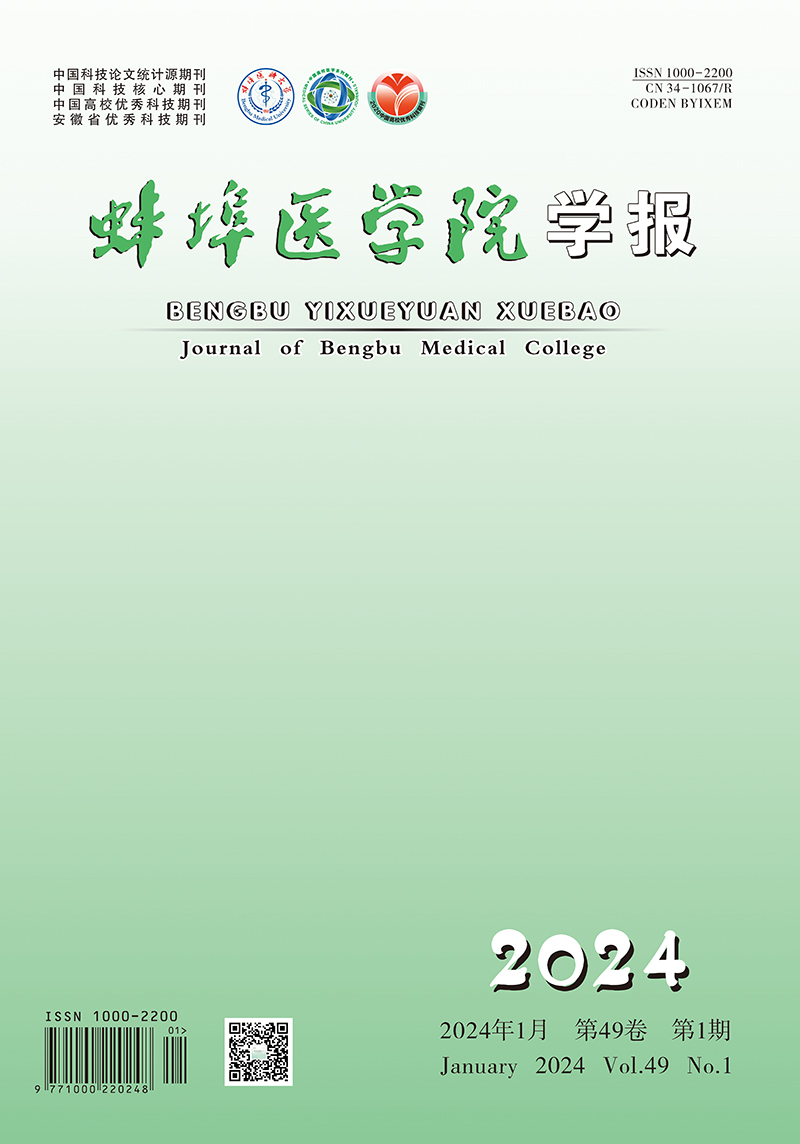-
据2018年全球癌症统计报告,2018年全球女性新增癌症病例8 622 539例,乳腺癌占比24.2%,是女性病人最常见的恶性肿瘤。女性癌症死亡病例4 169 387例,乳腺癌占比第一,为15.0%,乳腺癌已成为女性最常见恶性肿瘤致死的原因[1]。中国2014年恶性肿瘤统计,我国乳腺癌每年新发例数约27.9万,其死亡构成比7.8%,居我国女性恶性肿瘤死亡第5位[2]。临床观察[3]有相当比例乳腺癌女性病人存在焦虑抑郁的不良情绪,负面情绪会降低病人免疫力,增加组织中炎症介质,加重化疗的不良反应,同时会使部分病人依从性降低,治疗效果下降。本研究采取调查问卷的形式,收集289份乳腺癌病历资料,通过分析影响病人焦虑抑郁情绪存在的相关因素,以供临床治疗活动参考。现作报道。
HTML
-
选取2019年4-10月就诊于蚌埠医科大学第一附属医院肿瘤外科乳腺癌病人289例。纳入标准[4]: (1)年龄20~70岁,女性;(2)经病理学检查确诊为乳腺癌并接受手术和化疗,化疗方案一致;(3)有一定文字阅读能力者;(4)通过临床医师判断能耐受测查并自愿签署知情同意书。排除标准: (1)伴有严重脏器疾病或其他恶性肿瘤;(2)精神或意识障碍;(3)服用抗焦虑、抑郁药物。
-
采用自制调查表,内容涉及年龄、病程、家庭居住地、文化程度、家庭月收入、气质类型、宗教信仰、性功能需求、新辅助化疗、腋窝淋巴结清扫、保留乳房、手术并发症、严重化疗反应、临床分期、免疫组化分型15种因素统计目标病人的一般资料。气质类型评定采用艾森克人格问卷简式量表中国版,共48个项目,包括精神质(P)、内外向(E)、神经质(N)和掩饰性(L)四个维度。本研究仅就内外向与神经质两个维度讨论; E与N维度结合,构成四个气质类型,即外向-不稳定(胆汁质);外向-稳定(多血质);内向-稳定(黏液质);内向-不稳定(抑郁质)。焦虑和抑郁评定采用文献[5]中的焦虑自评量表(self-rating anxiety scale, SAS)和抑郁自评量表(self-rating depression scale,SDS), 由所有病人于入院确诊后的第1天和术后第5天完成测查进行自评(取均值)。对病人中具有初中及以上文化程度者,确定其对量表内容充分理解后由病人亲自填写完成;对文化程度低的病人,由接受过培训的调查员对病人进行讲解,但问卷均由病人亲自填写,自评时请家属回避,并当场收回量表。病人按自已的感受对量表中的20个项目进行评分,把20个项目的分数相加即得到总粗分,然后通过公式转换: Y=Int(1.25X),其中Y为标准分,X为总粗分,Y即为1.25倍总粗分的整数部分。标准分≥50分提示存在焦虑或抑郁情绪。最后,将得到的数据分别与文献[5]中我国常模SAS和SDS数据进行比较。
-
采用χ2检验和t检验。
1.1. 一般资料
1.2. 方法
1.3. 统计学方法
-
289例SAS评分为(57.58±6.83)分,评分明显高于中国常模(33.80±5.90)分(t=11.70, P < 0.01)。存在焦虑不良情绪者44例,阳性率为15.22%(44/289)。单因素分析结果显示,腋窝淋巴结清扫、术前有新辅助化疗和严重化疗反应是乳腺癌病人焦虑的影响因素(P < 0.05~P < 0.01)(见表 1)。
项目 焦虑组
(n=44)非焦虑组
(n=245)χ2 P 年龄/岁 ≤50
>5023(52.27)
21(47.73)129(52.65)
116(47.35)0.00 >0.05 病程 ≤3个月
>3个月21(47.73)
23(52.27)115(46.94)
130(53.06)0.01 >0.05 居住地 农村
城市30(68.18)
14(31.82)195(79.59) 2.82 >0.05 文化程度 ≤初中
>初中33(75.00)
11(25.00)210(85.71)
35(14.29)3.20 >0.05 腋窝清扫 是
否16(36.36)
28(63.64)132(53.88) 4.58 < 0.05 保乳手术 是
否12(27.27)
32(72.73)47(19.18)
198(80.82)1.50 >0.05 术前新辅助化疗 有
无23(52.27)
21(47.73)70(28.57)
175(71.43)9.60 < 0.01 免疫组化分型 LuminalA 9(20.45) 18(7.35) LuminalB
HER-217(38.64)
13(29.55)116(47.35)
79(32.24)7.64 >0.05 三阴 5(11.36) 32(13.06) 严重并发症 是
否14(31.82)
30(68.18)20(8.16)
225(91.84)18.94 >0.05 宗教信仰 有
无16(36.36)
28(63.64)74(30.20)
171(69.80)0.66 >0.05 家庭月收入/元 ≤3 000
>3 00026(59.09)
18(40.91)134(54.69)
111(45.31)0.29 >0.05 性功能需求 有
无25(56.82)
17(43.18)176(71.84)
69(28.16)2.59 >0.05 气质类型 多血质 16(36.36) 53(21.63) 胆汁质
黏液质9(20.45)
7(15.91)91(37.14)
70(28.57)7.47 >0, 05 抑郁质 12(27.27) 31(12.65) 临床分期 ≥Ⅱ期
< Ⅱ期31(70.45)
13(29.55)177(72.24)
68(27.76)0.06 >0.05 严重化疗反应 有
无23(52.27)
21(47.73)71(28.98)
174(71.02)9.22 < 0.01 -
289例SDS评分为(56.48±7.215)分,明显高于中国常模(41.9±30.6)分(t=22.67,P < 0.01)。其中,存在抑郁不良情绪者68例,阳性率为23.53%(68/289)。单因素分析结果显示,术前有新辅助化疗、严重化疗反应、文化程度、气质类型是乳腺癌病人抑郁的影响因素(P < 0.05~P < 0.01)(见表 2)。
项目 抑郁组
(n=68)非抑郁组
(n=221)χ2 P 年龄/岁 ≤50
>5037(54.41)
31(45.59)116(52.49)
105(47.51)0.08 >0.05 病程 ≤3个月
>3个月28(41.18)
40(58.82)107(48.42)
114(51.58)1.38 >0.05 居住地 农村
城市49(72.06)
19(27.94)176(79.64)
45(20.36)1.73 >0.05 文化程度 ≤初中
>初中64(94.12)
4(5.88)187(84.62)
34(15.38)4.11 < 0.05 腋窝清扫 是
否30(44.12)
38(58.88)113(51.13)
108(48.87)1.02 >0.05 保乳手术 是
否17(25.00)
51(75.00)35(15.84)
186(84.16)2.96 >0.05 术前新辅助化疗 有
无31(45.59)
37(54.41)65(29.41)
156(70.59)6.13 < 0.05 免疫组化分型 LuminalA 8(11.76) 13(5.88) LuminalB
HER-228(41.18)
18(26.47)114(51.58)
68(30.77)6.87 >0.05 三阴 14(20.59) 26(11.76) 严重并发症 是
否13(19.12)
55(80.88)23(10.41)
198(89.59)3.62 >0.06 宗教信仰 有
无29(42.65)
39(57.35)68(30.77)
153(69.23)2.39 >0.05 家庭月收入/元 ≥3 000
< 3 00041(60.29)
27(39.71)119(53.85)
102(46.15)0.87 >0.05 性功能需求 有
无40(58.82)
28(41.18)157(71.04)
64(28.96)3.58 >0.05 气质类型 多血质 12(17.65) 52(23.53) 胆汁质
黏液质20(29.41)
19(27.94)85(38.46)
62(28.05)10.71 < 0.05 抑郁质 17(25.00) 22(9.95) 临床分期 ≥Ⅱ期
< Ⅱ期48(70.59)
20(29.41)163(73.76)
58(26.24)0.26 >0.05 严重化疗反应 有
无29(42.65)
39(57.35)51(23.08)
170(76.92)9.95 < 0.01 -
289例乳腺癌病人中,抑郁人群里多血质占比最少为12.5%(8/64),抑郁质占比最多为35.0%(14/40)(见表 3)。
人格 n 抑郁 非抑郁 多血质 64 8(12.5) 56(87.5) 胆汁质 106 16(15.1) 90(84.9) 黏液质 79 14(17.7) 65(82.3) 抑郁质 40 14(35.0) 26(65.0) 合计 289 52(18.0) 237(82.0)
2.1. 乳腺癌病人焦虑情况及其影响因素
2.2. 乳腺癌病人抑郁情况及其影响因素
2.3. 不同人格的乳腺癌病人抑郁构成情况
-
当前临床乳腺癌病人的比例增加,乳腺癌的治疗及预后表现成为研究热点。大部分乳腺癌病人伴随不良情绪,以焦虑、抑郁为多。癌症伴有抑郁的病人比单纯癌症病人病死率增加19%[6]。存在抑郁情绪状态的病人机体免疫力会被极大程度遏制,从而导致癌症的发展[7]。有研究[8-9]表明,焦虑、抑郁负面情绪会使病人长期处于应激状态,总淋巴数下降,CD3、CD4下降,CD8增高,CD4/CD8下降,自然杀伤细胞活性减弱,肿瘤更容易恶化。国外SO等[10]对218例乳腺癌病人研究发现,存在焦虑或抑郁的病人占比分别为21.1%、34.4%。国内陈丽等[11-12]所做统计焦虑、抑郁分别为67.0%、52.0%。本研究中焦虑、抑郁占比分别为15.22%、23.54%,与前者的各焦虑、抑郁阳性率相比,比值偏低。分析原因可能是本次调查的对象主要是安徽淮北地区,调查对象具有地区差异性。相较于服务范围更大的肿瘤医院,蚌埠医科大学第一附属医院的服务群体也有其独特性,主要涉及基层群众的高级诊疗服务。本研究中预研究因素广泛,腋窝淋巴结清扫、术前新辅助化疗、严重化疗反应是影响乳腺癌病人焦虑的重要因素;文化程度、术前新辅助化疗、严重化疗反应、气质类型是影响乳腺癌病人抑郁的重要因素。
乳腺癌治疗目前以综合治疗为主。新辅助化疗为重要治疗手段,又被称为术前化疗,特指在手术或放疗等局部治疗前进行的化学药物治疗[13]。该化疗临床用于降低肿瘤分期,提供药敏实验等。相关研究[14]表明新辅助化疗会导致乳腺癌病人产生癌因性疲乏,降低病人预后水平。新辅助化疗与病人焦虑、抑郁情绪产生有关。但是不能否定新辅助化疗在乳腺癌治疗中的重要作用。新辅助化疗后病理完全缓解的预后意义是确切的,获得全缓解的病人无事件生存率和总生存率可明显改善,三阴性和HER2阳性的乳腺癌病人更加明显[15]。但是,就本研究具体对象而言,参试者是皖北地区已婚女性,经济能力有限。新辅助化疗一方面增加治疗周期,延长住院时间,导致病人家庭角色与责任长时间缺失;一方面增加治疗费用,加重经济负担。两者可能加重病人焦虑、抑郁情绪,影响病情恢复。同时,研究发现多数病人对呕吐、失眠等不良反应有恐惧心理,这些不良反应在下一次化疗周期未进行前就开始发生。为了改善这种现象,医护人员可以向病人详细说明化疗期间的注意事项,减轻他们对不良反应事件疾病严重性之间的错误联想;争取病人家属及好友的社会心理支持,以缓解心理应激;鼓励培养病人个人兴趣,根据自己的爱好适度参加娱乐活动,转移对无法改变的化疗不良反应的注意力。改善认知行为,加强心理支持,可改善病人负面情绪及生活质量[16]。医护人员也应着重关注,积极回应病人在不良化疗反应方面的疑问,根据病人异质性,确定化疗方案。
另外,乳腺癌改良根治术仍是治疗的主要手段,及早进行手术可有效提高乳腺癌治愈率。随之受到关注的便是术后疼痛综合征的发生。术后疼痛综合征是一种发生在术后的神经病理性疼痛。研究[17]显示,乳腺癌术后慢性疼痛发生率高达20%~68%,甚至有些长达数年。胡海北等[18]研究结果也显示乳腺癌术后疼痛综合征的发生率为21.15%,且疼痛部位多在腋窝。有数据显示腋窝淋巴结清扫是乳腺癌术后疼痛综合征的独立危险因素[18-19]。究其原因,可能是因为手术中难免损伤肋间臂神经,或挤压牵拉神经引起慢性痛[20]。慢性疼痛可普遍伴发焦虑、抑郁情绪,二者之间有高度关联性[21],会降低病人生活质量,影响预后。
本研究数据显示,存在抑郁的乳腺癌病人多血质占比12.5%,胆汁质、黏液质占比中等,抑郁质占比35.0%,不同的气质类型与抑郁情绪的生成有相关性。性格内向、情绪不稳定、容易受外界影响的乳腺癌病人比性格外向、情绪稳定的个体更容易产生抑郁情绪。一方面,人格特质与应对事件方式和自我效能有相关性[22]。外向性人格易采取积极的应对方式缓解心理负担,善于沟通,与人相处友好,社会支持利用度高,能够保持良好的情绪。内向型、不稳定性人格更多采取屈服、回避等消极应对方式,易产生抑郁的情绪。另一方面,人格特征与癌因性疲乏亦有关联[23]。就抑郁质病人而言,存在负面情绪与不存在负面情绪的病人在总体疲乏、躯体疲乏、情感疲乏、认知疲乏都有差异。
最后,本研究还发现文化程度的高低亦是乳腺癌病人抑郁的影响因素,二者有相关性。本研究中大部分研究对象学历均为初中以下。低学历致使病人相对高学历者不易理解自己的病情,自主学习能力较差,对疾病认知有限,心理负担大。此外,绝大多数乳腺癌治疗都会导致女性第二特征的缺失。文化程度高的女性思想觉悟更高,更容易接受此现象,并且可以从其他方面获得精神世界的满足,更容易保持积极乐观的心态对抗疾病。最后,文化程度相对较低的女性经济压力方面可能较高,无法选择更好的治疗方案。疾病的病痛、经济的负担以及因此可能发生的家庭问题都会加重病人不良情绪。因此,治疗过程中,医护人员可采取多形式(图片、视频媒体等)宣教,了解乳腺癌的治疗发展,消除不安,减少抑郁情绪的伴发。
焦虑、抑郁是乳腺癌治疗过程中最常见的不良反应,降低病人免疫力,影响病人治疗依从性与战胜疾病的信心,危害极大,因此其影响因素的研究需引起重视。本研究显示术前新辅助化疗与严重的化疗反应是焦虑、抑郁产生的危险因素; 文化程度、气质类型是抑郁产生的危险因素;腋窝淋巴结的清扫是焦虑产生的危险因素。针对这些影响因素,临床应尽早干预,减少抑郁、焦虑等负面情绪导致的不良反应,提高治疗效果与病人生存率。






 DownLoad:
DownLoad: